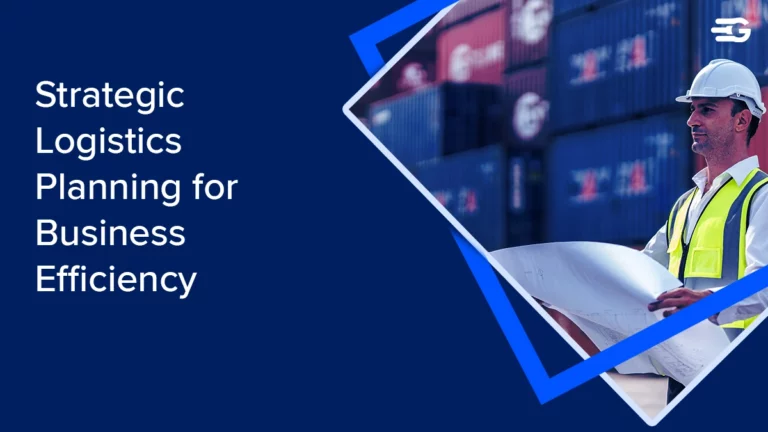Enhancing Logistics Efficiency with Strategic Load Planning
In logistics, one key player quietly ensures smooth operations: load planning. It’s all about strategically organizing cargo in trucks, containers, and warehouses.Load planners are like puzzle solvers, arranging items efficiently to make the most of available space.
But it’s not just about fitting things in; it’s also about saving time and money by optimizing delivery routes. Effective load planning isn’t just about logistics; it’s about sustainability too. Reducing trips, it helps cut emissions and minimize environmental impact. Thanks to supply chain automation, logistics professionals now have powerful tools to enhance their strategies.
The Art of Load Planning
What Constitutes Load Planning
It involves the strategic arrangement of cargo within a designated space. It’s a meticulous process that considers factors like:
- Item dimensions and weight: Tetris-like spatial awareness is key to maximizing space utilization without exceeding weight limits.
- Center of gravity: Maintaining a balanced load is crucial for safe and efficient transportation, preventing accidents and damage to goods.
- Fragile items and stacking order: Delicate cargo needs special attention to prevent crushing. Load planning dictates the order items are placed, ensuring fragile goods are positioned safely.
- Delivery sequence: Optimizing the unloading order based on delivery stops minimizes time spent rearranging cargo at each destination.
Advantages of Precision in Load Planning
The meticulous art of load planning translates into a multitude of advantages for logistics operations:
- Reduced transportation costs: By maximizing space utilization, fewer trucks are needed, leading to significant fuel savings and lower transportation costs.
- Enhanced efficiency: Optimized loading and unloading processes minimize wasted time and resources at warehouses and delivery points.
- Improved safety: A balanced and secure load reduces the risk of accidents and damage to cargo during transportation.
- Increased sustainability: Fewer trips due to maximized space utilization translates to lower CO2 emissions, contributing to a greener supply chain.
- Enhanced customer satisfaction: Faster delivery times and reduced risk of damaged goods lead to a more satisfied customer base.
Load Planning Challenges and Technological Solutions
Navigating Common Load Planning Challenges
Despite its advantages, load planning faces several challenges in today’s complex logistics ecosystem:
- Inaccurate data: Inaccurate information about cargo dimensions, weight, and fragility can throw off load plans, leading to inefficiencies.
- Dynamic order changes: Last-minute order additions or cancellations disrupt pre-planned loading schedules.
- Manual processes: Traditional, manual load planning methods are time-consuming and prone to errors.
- Limited visibility: Difficulty in tracking available transport capacities and real-time inventory levels can hinder optimal load planning.
- Compliance considerations: Navigating a web of regulations regarding weight limits, safety protocols, and hazardous materials transportation adds another layer of complexity to load planning.
The Role of Automation in Overcoming Load Planning Hurdles
Thankfully, the rise of supply chain visibility solutions provides powerful tools to address these challenges:
- Real-time data integration: Automation tools integrate with warehouse management systems (WMS) and other platforms, ensuring access to accurate and up-to-date information on cargo specifics.
- Dynamic load optimization software: These intelligent systems analyze data and generate optimal load plans based on real-time factors, accommodating last-minute changes efficiently.
- Improved visibility: Automation platforms offer a centralized dashboard for tracking available space on trucks and trailers, providing complete visibility into inventory levels.
- Compliance management tools: Advanced supply chain management software can help ensure load plans adhere to weight restrictions, safety regulations, and proper handling procedures for hazardous materials.
Load Planning in Action: Techniques and Technologies
Innovative Techniques for Optimizing Load Planning
Modern load planning goes beyond basic space utilization. Here are some innovative techniques for maximizing efficiency:
- 3D load visualization software: These tools create digital models of trucks and containers, allowing planners to visualize cargo placement virtually before physical loading. This minimizes errors and wasted time during the actual loading process.
- Weight distribution optimization: Advanced software calculates the ideal weight distribution within the designated space for optimal vehicle handling and safety. This is particularly important for oversized or overweight cargo.
- Multi-stop route optimization: Load plans can be designed with specific delivery routes in mind, minimizing time spent rearranging cargo at each stop. By taking into account factors like traffic congestion and distance between stops, planners can create a more efficient unloading sequence.
- Nestling techniques: This involves strategically placing smaller items in the gaps between larger ones, maximizing space utilization without compromising safety or stability of the load.
Embracing Technology for Enhanced Load Management
Technology plays a vital role in refining load planning processes. Here’s how:
- Transportation Management Systems (TMS): These comprehensive platforms, such as software for transportation management, integrate various logistics functions, including advanced load planning tools. TMS simplifies operations by facilitating streamlined communication with carriers, offering real-time tracking information, and ensuring better coordination throughout the transportation process. This leads to enhanced efficiency and improved decision-making across the supply chain.
- Route optimization software: Optimizing delivery routes based on factors like traffic and distance minimizes travel time and allows for better planning of loading sequences. This can also help reduce fuel consumption and emissions.
- Mobile applications: Mobile apps empower load planners to access data and manage tasks on the go, facilitating real-time adjustments based on changing circumstances. For instance, drivers can receive updated load plans based on traffic delays or last-minute order changes.
- Warehouse automation: Integrating automation technologies within warehouses, such as automated storage and retrieval systems (AS/RS) and conveyor belts, can significantly improve the efficiency of loading processes. These systems can streamline the picking, packing, and sorting of goods based on the pre-determined load plan.
- Telematics integration: Telematics systems installed in vehicles provide real-time data on factors like weight distribution, trailer temperature, and potential mechanical issues. This data can be integrated with load planning software to ensure optimal loading practices and prevent damage to cargo during transit.
Load Planning: A Strategic Component in Logistics
Incorporating Load Planning into Broader Logistics Strategy
Load planning isn’t an isolated function; it’s a vital cog in the well-oiled machine of your logistics strategy. Here’s how it integrates with the bigger picture:
- Inventory management: Accurate inventory data is crucial for effective load planning. Knowing what’s available and where it’s located allows for efficient allocation of goods to specific loads. Additionally, inventory forecasting can help anticipate future demand and plan load capacities accordingly.
- Warehouse operations: Optimized load plans require a smooth workflow within the warehouse. Automation of picking and packing processes, as mentioned earlier, ensures timely order fulfillment and efficient loading based on the planned sequence.
- Transportation management: Load planning facilitates communication with carriers, ensuring they have the necessary information about the weight, dimensions, and specific handling requirements for the cargo they’re transporting. This helps carriers select the appropriate vehicles and plan their routes effectively.
- Customer service: Efficient load planning ultimately contributes to improved customer service. By optimizing delivery times and minimizing the risk of damaged goods, logistics companies can ensure a more reliable and positive experience for their customers.
The Future of Load Planning: Trends to Watch
The landscape of load planning is constantly evolving, driven by technological advancements and changing industry demands. Here are some key trends to watch:
- The rise of artificial intelligence (AI): AI-powered algorithms will play an increasingly prominent role in load planning. By analyzing vast amounts of data on historical trends, traffic patterns, real-time conditions, and even weather forecasts, AI can suggest even more optimized loading strategies, taking into account factors beyond human capabilities.
- Predictive analytics: Advancements in data analytics will enable load planning tools to predict future demand and optimize shipments accordingly. This can help logistics companies pre-plan and consolidate loads, reducing empty miles and optimizing overall efficiency. For instance, AI can predict peak seasons and suggest strategies for using available space more effectively during those periods.
- The Internet of Things (IoT): The integration of IoT devices into logistics operations provides real-time insights into factors like cargo temperature, weight distribution, and potential damage during transit. This data can be used to refine load plans and ensure the safe and efficient transportation of goods, particularly for temperature-sensitive items or those susceptible to damage from shifting during transport.
- Autonomous vehicles: While still in development, the emergence of autonomous trucks has the potential to revolutionize load planning. These vehicles could operate on optimized schedules based on real-time traffic conditions and pre-determined load plans, further increasing efficiency and reducing transportation costs. Additionally, autonomous vehicles could potentially operate for longer durations without requiring breaks, potentially leading to faster deliveries.
- Sustainability focus: As environmental concerns grow, load planning will play a crucial role in creating a more sustainable supply chain. Optimizing routes and maximizing space utilization will minimize fuel consumption and emissions. Additionally, load planning can be used to consolidate shipments and reduce the overall number of trucks needed, further minimizing the environmental impact of logistics operations.
Conclusion: Optimizing Load Planning with GoComet
Effective load planning is the cornerstone of efficient and cost-effective logistics. By leveraging automation tools and embracing new technologies, logistics companies can elevate their load planning strategies to a whole new level.
GoComet offers a comprehensive suite of supply chain automation tools specifically designed to streamline load planning processes. From real-time data integration and dynamic load optimization to mobile applications and integration with TMS platforms, GoComet empowers you to:
- Reduce transportation costs through optimized space utilization and minimized empty miles.
- Enhance efficiency with faster loading and unloading times, minimizing delays.
- Improve safety with balanced and secure load distribution.
- Increase sustainability by reducing fuel consumption and CO2 emissions.
- Enhance customer satisfaction through faster delivery times and a lower risk of damaged goods.
Don’t let manual processes and outdated tools hold back your logistics potential—upgrade to software for logistics management for streamlined operations and improved efficiency
Contact GoComet today and discover how our innovative automation solutions can transform your load planning strategy, driving efficiency, cost savings, and a more sustainable supply chain.
Beyond the core functionalities, GoComet offers additional benefits to empower your load planning efforts:
- Scalability: Our solutions adapt to your growing business needs, accommodating fluctuations in shipment volume and complexity.
- Improved communication: GoComet facilitates seamless communication between all stakeholders involved in the logistics process, from planners and warehouse personnel to carriers and customers. This ensures everyone is on the same page and potential issues can be addressed promptly.
- Data-driven decision making: GoComet provides comprehensive reporting and analytics tools. You can gain valuable insights into historical load planning performance, identify areas for improvement, and make data-driven decisions to continuously optimize your strategies.
- Enhanced visibility: With GoComet’s real-time tracking capabilities, you can monitor the status of your shipments throughout their journey, providing greater transparency for both your internal teams and your customers.





